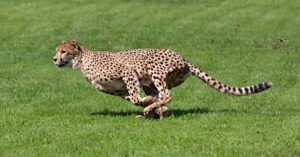Cheetahs are renowned for being the fastest land animals in the world, capable of reaching speeds of up to 75 miles per hour. However, despite being one of the major predators within their home range, cheetahs face several serious threats that threaten their very existence. These threats mean that their population is in decline, but are cheetahs endangered? Read on to find out!
Where Do Cheetahs Live?
Cheetahs are distinctive wild cats with tawny-colored bodies and black spots that are arranged in a pattern that is unique to every individual animal. Cheetahs live in scattered locations across Africa and central Iran. There are five subspecies — east African, northeast African, northwest African, southeast African (the nominate subspecies), and the Asiatic cheetah.
Cheetahs live in a variety of habitats, including grasslands, mountains, and even deserts. They are diurnal animals, being active during the day. They prey on a range of animals, such as impala, gazelle, and nyala, which they stalk before attacking using their devastating burst of speed.
Female cheetahs are primarily solitary animals, living and hunting alone, with the exception of when they have cubs. However, male cheetahs may sometimes form small groups consisting of two or three individuals. This can be particularly useful for taking down larger prey, as they can work together as a group. Despite this, females tend to have a larger home range and live a relatively nomadic lifestyle, especially if prey is scarce. In comparison, males will typically form a set territory.
Are Cheetahs Endangered?

Cheetahs are a vulnerable species and face a real danger of extinction.
©iStock.com/StuPorts
Cheetahs are currently classed as a vulnerable species on the IUCN Red List. There are currently around 6,500 adult cheetahs left in the world, but the population is declining. The majority of these cheetahs live in Africa as the Asiatic subspecies — the only cheetah in Asia — has now been reduced to less than 50 individuals. However, some estimates suggest that this number may be much less and that the subspecies may well be right on the verge of extinction.
Why Are Cheetahs Threatened?
Cheetahs are threatened for several reasons, including habitat loss, hunting, loss of prey animals, the exotic pet trade, and a low reproductive rate. Let’s explore them in more detail.
Hunting
Unfortunately, cheetahs are hunted in many areas. In some cases, they are captured alive and sold into the exotic pet trade or to places that use them as an attraction. However, cheetahs are also hunted and killed for their body parts, several of which are used in traditional medicines.
Habitat Loss

Cheetahs are seriously threatened by habitat loss and the resulting loss of prey and human-animal conflict.
©Wayne Marinovich/Shutterstock.com
One of the main threats to cheetahs is habitat loss. As we already mentioned, cheetahs have a large home range, with some being as much as 300 square miles. Human settlements and agricultural areas are continually expanding, encroaching more and more into the cheetah’s natural habitat as well as fragmenting the remaining areas with roads and other infrastructure.
This habitat loss has a two-fold effect on cheetahs. When human areas expand they are not just affecting cheetahs, but every single animal that lives there. Many of the animals that make up a cheetah’s diet are also driven into different ranges or are now hunted by the people who live nearby. This means that there’s less food available for cheetahs as well as greater competition for the prey that is around. As a result, cheetahs only have a 40 to 50% success rate when hunting.
The other consequence of habitat loss is human-cheetah conflict. As human areas are now closer to the cheetah’s territories there’s a greater chance of cheetahs coming into contact with people. This is further enhanced by the lack of prey, which causes cheetahs to go looking for other food, often in the form of livestock. As a result, many cheetahs are shot and killed in retaliation.
Low Reproductive Rate

Cheetahs actually have a low reproductive rate due to events thousands of years ago.
©Stu Porter/Shutterstock.com
One of the major factors that is affecting an already declining population is the low reproductive rate of cheetahs. This means that they are not able to reproduce quickly enough to counteract the decline. The low reproductive rate is largely because they have a small gene pool, meaning that attempts at reproducing are not always successful.
This reduced gene pool is due to two “bottleneck events” that occurred in the past (around 100,000 years ago and around 10,000 years ago). These events caused extreme declines in the population, which also meant that there were far fewer breeding animals. This caused inbreeding, resulting in a smaller gene pool and less genetic variability. Another consequence of this is that cheetahs have now become more susceptible to diseases, including those from domestic cats, as they are unable to fight them effectively due to their smaller gene pool.
Conservation Efforts
Several organizations are working to protect the cheetahs to try and prevent their extinction. This involves trying to stop the illegal trade of cheetahs as well as preventing them from being captured in the wild.
Additional work involves educating local communities and trying to come up with and promote alternative, sustainable solutions to allow humans and cheetahs to live alongside each other without conflict. This can be in the form of secure livestock enclosures to prevent the cheetahs from preying on them. It also involves providing financial assistance to farmers who have lost livestock to stop any retaliation killings.
The photo featured at the top of this post is © nwdph/Shutterstock.com
Thank you for reading! Have some feedback for us? Contact the AZ Animals editorial team.






